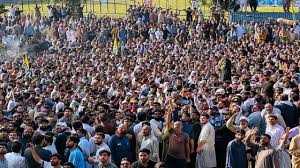
Muzaffarabad, Oct 2: On the call of Shaukat Nawaz Mir, the central leader of JKAAC, workers and supporters from all cities and towns across Pakistan-Occupied Kashmir (PoK) began a long march towards Muzaffarabad. Details are in the succeeding paragraphs.
Kotli. A complete shutdown was observed. All major entry and exit routes were blocked, and sit-in protests were organized by JKAAC workers.
Dhirkot. A convoy of approximately 2,000 JKAAC workers from Rawalakote and Bagh marched towards Muzaffarabad. However, police opened fire on the protestors when they reached Dhirkot. Reportedly, four civilians were killed and approximately sixteen individuals, including civilians and local police personnel, were injured during the clashes.
Muzaffarabad. A sit-in protest was organized by approximately 2,000 people at Lal Chowk against the casualties in Dhirkot. The protest was later shifted to the Muzaffarabad bypass to await the convoys arriving from other places. Reports indicated aerial firing and tear gas shelling. Two civilians were reported killed.
Dadyal. A convoy of JKAAC workers from Chakswari and Islamgarh, marching towards Muzaffarabad, was fired upon by police, resulting in the deaths of two individuals and injuries to approximately ten others.
Actions by the Government. The Chief Secretary of the PoK government issued a notice inviting JKAAC leaders for negotiations. However, the PoK government also warned the JKAAC leadership of strict action if the protests were not called off.
Protests in London. JKAAC workers in London have announced a protest in front of the Pakistan High Commission in London on 02 October 2025.
Narrative by Pakistani Establishment. It is ironic that pro-Pakistani Establishment social media platforms are portraying these indigenous protests as the handiwork of external agencies, rather than moving towards settlement with the affected population. Historically, the Pakistan Establishment has had a pattern of blaming every internal upheaval on external forces. The Tehreek-e-Taliban Pakistan (TTP) insurgency has repeatedly been dubbed by Inter-Services Public Relations (ISPR) as "Indian sponsored," while the armed rebellion in Balochistan is labelled under the narrative of "Fitna-al-Hindustan." This reflects a continuation of the Establishment’s tactic of deflecting accountability by externalizing blame.
Muzaffarabad, Oct 2: On the call of Shaukat Nawaz Mir, the central leader of JKAAC, workers and supporters from all cities and towns across Pakistan-Occupied Kashmir (PoK) began a long march towards Muzaffarabad. Details are in the succeeding paragraphs.
Kotli. A complete shutdown was observed. All major entry and exit routes were blocked, and sit-in protests were organized by JKAAC workers.
Dhirkot. A convoy of approximately 2,000 JKAAC workers from Rawalakote and Bagh marched towards Muzaffarabad. However, police opened fire on the protestors when they reached Dhirkot. Reportedly, four civilians were killed and approximately sixteen individuals, including civilians and local police personnel, were injured during the clashes.
Muzaffarabad. A sit-in protest was organized by approximately 2,000 people at Lal Chowk against the casualties in Dhirkot. The protest was later shifted to the Muzaffarabad bypass to await the convoys arriving from other places. Reports indicated aerial firing and tear gas shelling. Two civilians were reported killed.
Dadyal. A convoy of JKAAC workers from Chakswari and Islamgarh, marching towards Muzaffarabad, was fired upon by police, resulting in the deaths of two individuals and injuries to approximately ten others.
Actions by the Government. The Chief Secretary of the PoK government issued a notice inviting JKAAC leaders for negotiations. However, the PoK government also warned the JKAAC leadership of strict action if the protests were not called off.
Protests in London. JKAAC workers in London have announced a protest in front of the Pakistan High Commission in London on 02 October 2025.
Narrative by Pakistani Establishment. It is ironic that pro-Pakistani Establishment social media platforms are portraying these indigenous protests as the handiwork of external agencies, rather than moving towards settlement with the affected population. Historically, the Pakistan Establishment has had a pattern of blaming every internal upheaval on external forces. The Tehreek-e-Taliban Pakistan (TTP) insurgency has repeatedly been dubbed by Inter-Services Public Relations (ISPR) as "Indian sponsored," while the armed rebellion in Balochistan is labelled under the narrative of "Fitna-al-Hindustan." This reflects a continuation of the Establishment’s tactic of deflecting accountability by externalizing blame.
© Copyright 2023 brighterkashmir.com All Rights Reserved. Quantum Technologies